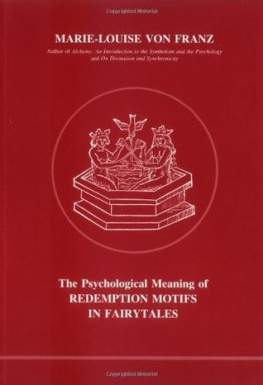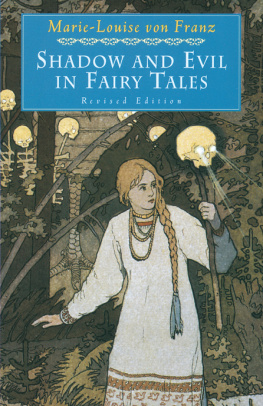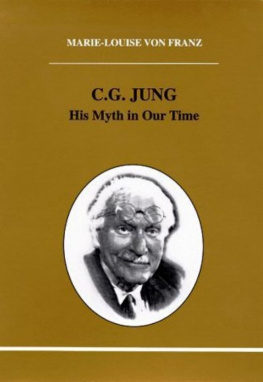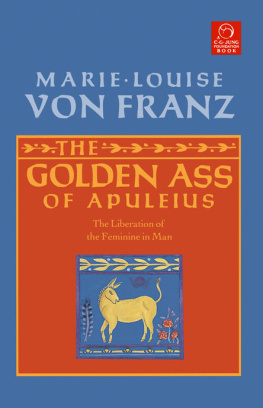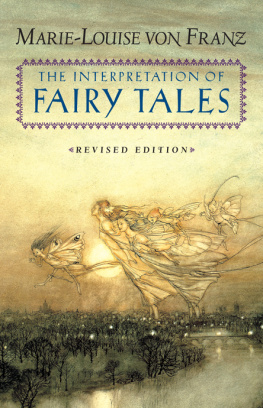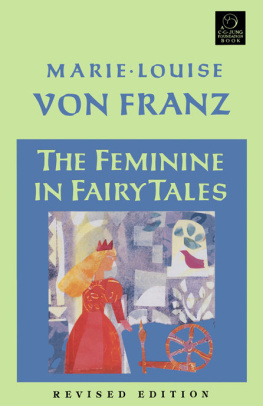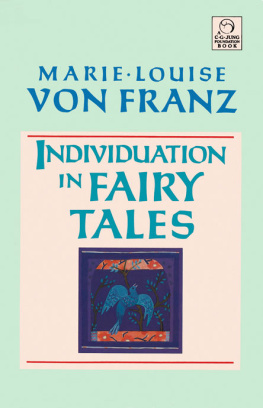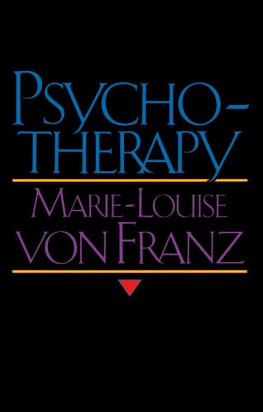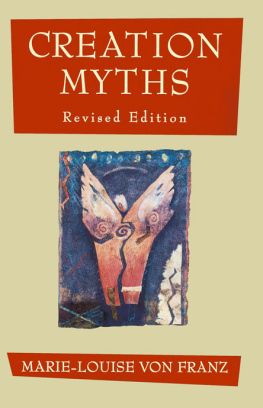Marie-Louise von Franz - The Psychological Meaning of Redemption Motifs in Fairytales
Here you can read online Marie-Louise von Franz - The Psychological Meaning of Redemption Motifs in Fairytales full text of the book (entire story) in english for free. Download pdf and epub, get meaning, cover and reviews about this ebook. year: 0, genre: Science. Description of the work, (preface) as well as reviews are available. Best literature library LitArk.com created for fans of good reading and offers a wide selection of genres:
Romance novel
Science fiction
Adventure
Detective
Science
History
Home and family
Prose
Art
Politics
Computer
Non-fiction
Religion
Business
Children
Humor
Choose a favorite category and find really read worthwhile books. Enjoy immersion in the world of imagination, feel the emotions of the characters or learn something new for yourself, make an fascinating discovery.
- Book:The Psychological Meaning of Redemption Motifs in Fairytales
- Author:
- Genre:
- Year:0
- Rating:5 / 5
- Favourites:Add to favourites
- Your mark:
- 100
- 1
- 2
- 3
- 4
- 5
The Psychological Meaning of Redemption Motifs in Fairytales: summary, description and annotation
We offer to read an annotation, description, summary or preface (depends on what the author of the book "The Psychological Meaning of Redemption Motifs in Fairytales" wrote himself). If you haven't found the necessary information about the book — write in the comments, we will try to find it.
Marie-Louise von Franz: author's other books
Who wrote The Psychological Meaning of Redemption Motifs in Fairytales? Find out the surname, the name of the author of the book and a list of all author's works by series.
The Psychological Meaning of Redemption Motifs in Fairytales — read online for free the complete book (whole text) full work
Below is the text of the book, divided by pages. System saving the place of the last page read, allows you to conveniently read the book "The Psychological Meaning of Redemption Motifs in Fairytales" online for free, without having to search again every time where you left off. Put a bookmark, and you can go to the page where you finished reading at any time.
Font size:
Interval:
Bookmark:
La inmersin en el bao. Conferencias 2
Cubrirse con piel de animal. Conferencias 2
Golpear con el avellano. Conferencias 2
Comer flore. Conferencias 1
Conversin en un animal. Conferencias 3
Espritu suicida. Conferencia 4
El momento oportuno. Conferencias 4
Quema de la piel. Conferencias 4
El arco y la flecha. Conferencias 4
Un palacio en el bosque. Conferencia 5
El prncipe. Conferencias 1
El silencio. Conferencias 3
La camisa. Conferencias 3
El aporte de la luz. Conferencias 3
El beso. Conferencias 1
La decapitacin. Conferencias 2
ndice de cuentos citados
The word redemption is not necessarily associated with the Christian dogma or theology, with its concept has many connotations. In fairy tales, redemption refers specifically to the circumstances in which someone who has been cursed or bewitched is released through certain contingencies or events in the course of history. Their nature differs essentially from the Christian idea.
The kind of curse is variable. A myth, fable or fairytale, a creature generally is it doomed to take the form of an animal or the existence of an old and monstrous woman or a horrible old man and then through the process of redemption, is transformed a prince or a princess. The most diverse animals, distinguished in two large groups of warm-blooded and cold-blooded, such as bears, foxes and lions, which often find the topic that interests us, have given the same symbols and myths. We can also find -patos birds, crows, pigeons, swans, bhos-or may simply be snakes. In other cases, someone who has been cursed, is forced, as a result, and without wishing to exercise evil and destruction. For example, a murderous princess to all her lovers, but in the end, when released from the spell, and by virtue of that redemption, explains that he was violently driven by the power of magic ritual to behave in this way, a situation that will not be repeated. It will not do evil. These are the main types of malignant destinations that a person can suffer in fairy tales, those fatal enchantments, of which he or she are finally redeemed.
Among the many fairy tales I have not chosen a fiction in particular, but I preferred to thoroughly examine various issues created by fantasy present in all of them, to point out the different types of spells or curses, since that aspect, apart from
constitute the main reason, It also has important significance psychological.
A person caught in a neurotic state, in some respects may well be compared to a man bewitched. Forced to a very low level of behavior, people suffering from a neurosis is capable of acting jarring and so destructive to themselves and to others, with basic or instinctive motivations. Fairy tales describing such beings is not explicitly stop the problem of curse, but also address the method of redemption, and in this sense is much to learn, because of their similarity in the therapeutic processes and recovery.
During these processes, to give a general example, there are people who have haunted the need to be soaked in water or milk and sometimes even receive blows at the same time. Some people ask to be slaughtered as when they cut the head to foxes or lions. Others consider indispensable that love, make them touch, kiss and even that some people need feeding with flowers or other things like that.
There are also those who want to be covered with a skin belonging to a particular animal. There are people who feel the need to be challenged and others who can not stand to be asked anything. All these questions are identified as the kind of issues on which we will reflect carefully.
During therapy often it happens that doctors expect to find recipes and formulas, but unlike other psychological schools, -lamentndose-Jungs followers say that there are no recipes for different types of diseases. Each case is unique, a unique process with its unique circumstances and unique way. Each case is individual and different. Faced with such features we can say that we have no therapeutic recipes for different types of ailments. Therefore, it is not possible, then, that we treat the issue in a general way during a conference. We can, yes, advise those who are responsible for the professional monitoring of cases, about what should be their behavior to each individual patient. In this difficult situation in which the doctor or psychoanalyst lacks rules to achieve healing your patient becomes very important the interpretation of dreams. We believe that if we develop a deep understanding of the dreams of our patients, careful to keep a full objectivity, trying to recognize and separate our own theories, we already have a pattern of action.
I just mentioned makes it clear that so far in a therapeutic situation will only have as guidance and theoretical support, the ability to interpret objectively and careful topics that appear in dreams, through which can be reached at understanding of the unconscious proposals for the purpose of healing.
Here we enter a field that is not only individual, because although the healing process is always unique, fairy tales and myths offer representations of instinctual processes in which the psyche has a general validity.
At that level the collective unconscious processes are representations of typical treatments also typical diseases. In general, if for example, we know what it means to a bath for a haunted and patient dreams that analysis is comparable to a bath person, we have a direct knowledge of the type of treatment proposed. On the other hand, if in a dream find a subject where the need to cut appears to pieces a person, we also have an intuitive perception of the direction to take in the healing process and an indication to choose the method to be applied in this individual case. Obviously, there is always the question of who is the one who should bathe and which one must be slaughtered, but that information generally is provided by the patients dreams themselves.
Therefore, we must carefully examine this matter and look at the problem from the general point of view, making it difficult understanding the mythological matter and especially fairy tales or fragments of epic narratives Gilgamesh, observe how identification is supported by the fact that the heroes behave as human beings suffer, they are afraid, they are sad, they are happy, finally experience all the nuances of feelings. In addition, they often wonder how anyone: What should I do?. Through this approach the human realm and the possibility that people can easily identify with them. The heroes of myths, most are limited to a certain nationality that of fairy tales. With compelling reasons, scientists have pointed out that the heroes or heroines are very different be it fairy tales or myths. In fairy tales they are much less human, ie, have no inner life, psychic life. They do not speak with him themselves, have no doubts or uncertainties, and human reactions.
There the hero is brave, he never loses courage but instead continues to struggle to defeat the enemy. Heroin can withstand prolonged torture, will suffer until the end, until you reach your goal. we never mention human reactions they may have. So a scientist, Dr. Max Lthi, has come to express the heroes of folklore are figures in black and white, sort of clichs, with very characteristic features as skill, the ability of suffering, loyalty, etc., and are immutable figures until the end of the story. In a fairy tale never we will find something like a psychological conversion of their heroes, while a myth often appreciate them changing attitudes. In spite of
their very human characteristics, these heroes of fairy tales are not quite human.
This is because not just of types of human beings but of archetypes and therefore can not be compared directly with the human self. We can not take the hero like a man, or heroin as a woman.
Font size:
Interval:
Bookmark:
Similar books «The Psychological Meaning of Redemption Motifs in Fairytales»
Look at similar books to The Psychological Meaning of Redemption Motifs in Fairytales. We have selected literature similar in name and meaning in the hope of providing readers with more options to find new, interesting, not yet read works.
Discussion, reviews of the book The Psychological Meaning of Redemption Motifs in Fairytales and just readers' own opinions. Leave your comments, write what you think about the work, its meaning or the main characters. Specify what exactly you liked and what you didn't like, and why you think so.

